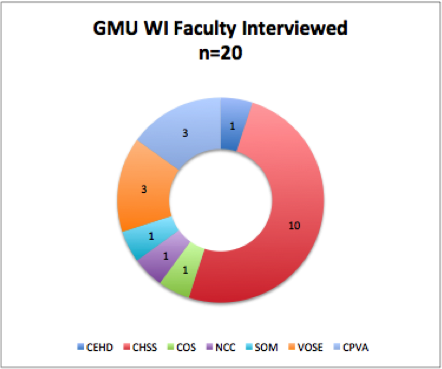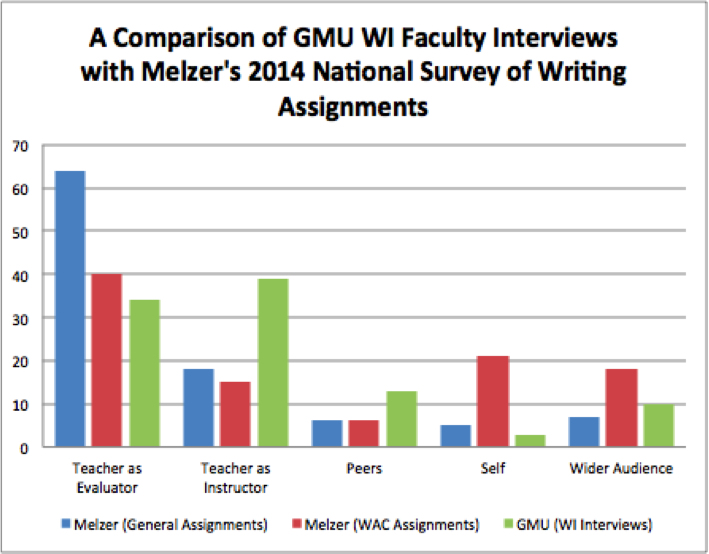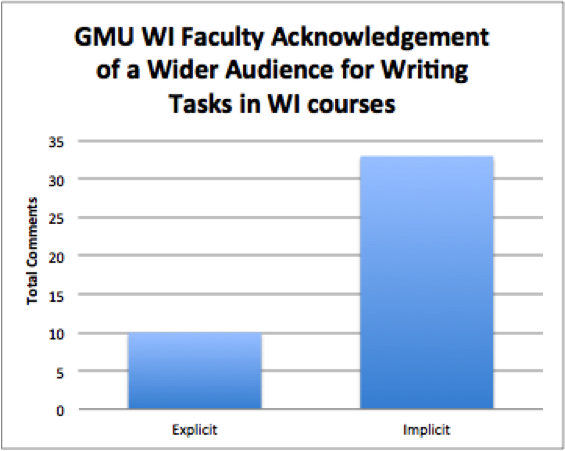Amber Jensen, PhD Candidate, Writing and Rhetoric
Audience is an essential element of any writing task, yet many instructors design assignments that conceptualize themselves as the only audience for student writing. In a recent national study of postsecondary writing assignments, for example, Melzer (2014) found that 82% of university writing tasks were designed with the instructor as the primary audience. Although Thaiss and Zawacki (2006) indicate that “writing for ‘an applied audience’ helps students write at a more sophisticated level” (p. 69), the audience defined for most postsecondary writing assignments is a teacher-evaluator who verifies student knowledge, assesses their writing, and assigns a grade.
Writing studies researchers have argued against this approach for some time. When an instructor is positioned as the central actor in an academic context—the only reader, the imagined audience, and the designer of the assignment—students are incentivized to write to receive a good grade rather than to engage the types of learning situations that lend to more effective writing in the long term.
In light of this gap, this semester-long study explored how WI faculty built audience awareness into their classes and assignments. Drawing from interviews and WI course assignments, this study sought to uncover relationships between instructor knowledge and beliefs about writing for various audiences and the audiences they posed in their writing assignment.
Research Study
During the Fall 2015 semester, I was one of a research team of 11 doctoral students in the English Department who collected data from a cross-section of Writing Intensive (WI) instructors and courses across George Mason University. For this study, the research team conducted interviews with 20 faculty members representing 7 colleges and 17 programs across campus (See Figure 1 below). After the research team conducted and transcribed interviews, I analyzed them to determine how participant instructors articulated the ways in which their assignment design and/or instructional practices reflected rhetorical  consideration of audience within required course writing tasks. The results reveal the ways that instructors articulated their explicit or implied understandings of audience in course writing assignments and/or instructional practices.
consideration of audience within required course writing tasks. The results reveal the ways that instructors articulated their explicit or implied understandings of audience in course writing assignments and/or instructional practices.
I selected five questions from the interview protocol that invited instructors to reflect on and discuss, both implicitly and explicitly, their general pedagogical approaches in WI courses. These five questions were asked as follows:
- How do you envision the WI-course preparing students to write for other courses in the major and/or after graduation?
- How do you support students in understanding the expectations for them as writers in your field? Can you comment on how similar or different your approach may be when compared to others in your department who also teach writing?
- What do you like about including writing assignments in your classes?
- What type of writing assignments (assignments submitted for your feedback) do you include in your WI-courses? Why?
- How do you work with student writers on those assignments? That is, how do you offer feedback on their work, support those who may be struggling (such as multilingual writers) or help students to better meet your expectations as a teacher?
While none of these questions directly asked instructors to articulate their understanding of specific rhetorical principles, such as audience, purpose, or genre, asking open-ended, rather than leading, questions allowed me to draw inferences from the general knowledge, values, and attitudes instructors shared about rhetorical practices.
Adopting the codes developed in Melzer’s (2014) study of 2,101 assignment sheets from postsecondary institutions across the nation as a baseline, I coded each interview with WI instructors for any explicit and/or implied mention of audience as they discussed course assignments and/or classroom instruction. A second round of coding distinguished between explicit and implicit mentions of audience when discussing pedagogical choices, applying subcategories of codes for audience in instructional materials and classroom practice that included: “Teacher as Instructor,” “Teacher as Evaluator,” “Peers,” “Self,” and “Wider Audience.”
Results and Discussion
- Instructors as Primary Audience. GMU WI instructors reflect national norms with regard to audience in writing tasks (See Graph 2 below). Instructors are most likely to design and assign writing that explicitly or implicitly defines the teacher as the primary audience: 73% of GMU WI instructors’ comments referencing audience featured teacher as audience, whether “teacher as evaluator” (e.g. gives grades, assigns point value to writing) or “teacher as instructor” (e.g. meets with students to discuss writing, leaves comments for revision).

These findings are consistent with both Melzer’s sample of 2,101 general postsecondary writing courses (in blue) and a subset of writing-intensive courses only (in red). A substantial distribution toward “teacher as instructor” in the GMU WI study is likely explained by the data collection process; instructors are more likely to represent themselves as instructors rather than evaluators as they discuss their pedagogical process and theories and beliefs about writing in an interview, whereas they are more likely to position themselves evaluators than instructors in a syllabus or assignment sheet, which was the source of Melzer’s data.
- Writing for a Wider Audience. Designing writing assignments to be addressed to wider audiences is central to reinforcing and modeling the rhetorical practices within disciplines and preparing students for writing situations beyond academia. While only 10 comments across 20 interviews indicated an assignment that explicitly identified a wider audience, 33 comments implicitly referenced an instructor’s classroom practice or discussion with students about how given writing tasks can be imagined toward or motivated by a wider audience (See Graph 3 below).

This is an important distinction to note because, although assignments may explicitly indicate the instructor as the evaluator or audience for a writing task, students may still gain important rhetorical understanding of hypothetical audiences if instructors discuss rhetorical implications of writing assignments in the context of class discussion, assignment instructions, or individual feedback to student drafts. Table 1 (below) offers a sample of interview responses that demonstrate how instructors both explicitly and implicitly connect writing assignments to wider audience in WI courses, either through assignment design or classroom instruction:
| Explicit Attention to Wider Audience | Implicit Attention to Wider Audience |
| Visual and Performing Arts:
“One of their revisions has to be a 5-minute video game narrative review which they can submit to a national competition at GDC, the big game developers’ conference. I think the big idea is that it has an audience–they’re not writing for me, they’re writing for a larger audience that is industry-relevant, because those are the people who read it.” School of Management: “We do a lot of modeling. We also have a cultural diversity [email] where [students] have to respond to an HR issue, like how to deal with other people in the workplace. They imagine that they’re the boss, so they have to respond to that situation, company-wide.” |
Athletic Training Education:
“We have grading rubrics which give them the specific nuances and details we’re looking for for each assignment, but I share a lot of the journals and their submission requirements, and we talk about what authors have to go through to get an article published in a journal, and the work they had to put in to get that article.”
Applied Developmental Psychology: “We have two big research projects that take the bulk of the draft-feedback-revision process. And that’s simply because it mimics the structure of what you would be reading in any peer-reviewed journal article.”
|
The examples from the School of Visual and Performing Arts as well as the School of Management exemplify how instructors explicitly identify, and even invite students to write specifically for, authentic audiences in the field, either by “imagin[ing] that [the student] is the boss, so they have to respond to that situation, company-wide” or by inviting students to submit their work to a national competition. Other instructors design their course writing assignments as part of an overall course design that introduces students to and engages them with the kinds of rhetorical situations and audiences students may encounter in their related scholarly and/or professional fields. The given example from Athletic Training Education contextualizes the students’ course writing tasks alongside opportunities for students to become familiar with academic journals and their submission requirements, which creates the potential for them to see beyond the course to where the writing task becomes relevant and contextualized to an authentic professional audience.
Summary of Results & Conclusions
This study shows that it is necessary to examine pedagogical decisions not only by collecting and evaluating course documents, but also by conducting interviews with instructors. These multiple sources allow researchers to understand the context of the choices faculty make and the ways that classroom interactions with students contribute to more effective writing. Instructors’ beliefs and understandings about writing are often reflected in their classroom practices, but may not feature directly in course syllabi, assignment sheets, and/or assessment rubrics, particularly when these documents are designed by committee.
The results of this study show that:
- Most instructors of WI courses at GMU design assignments that identify the teacher as the primary audience.
- Most instructors of WI at GMU courses do not explicitly or implicitly identify a wider, public, or disciplinary-specific audience in assignment design and classroom instruction.
- Some instructors of WI courses indicate attention toward a wider audience in assignment design and/or classroom instruction.
Recommended Teaching Strategies
The WAC program at George Mason University includes in its guiding principles that “students gain proficiency as writers when they have frequent opportunities . . . to [address] a range of audiences” and that “faculty across the curriculum share responsibility for helping students learn the conventions and rhetorical practices of their disciplines” (emphasis added). WAC faculty are encouraged to support student-writing development by asking their students to write for multiple, authentic, and disciplinary-relevant audiences in WI courses.
Many WI faculty at George Mason University are already developing writing tasks that include authentic disciplinary and professional audiences. Those who would like to engage students in more authentic rhetorical writing tasks might consider:
- Situating writing tasks in real-life settings that give students the opportunity to imagine an authentic audience (e.g., a scholarly journal, a report for a workplace committee, a submission to a creative production competition). When relevant and possible, invite students to submit their work to these audiences for real-world application.
- Engaging students in reading and analyzing the kinds of writing professionals and/or scholars in their particular field interact with: websites, journals, research reports, etc. Use course readings, where possible, as models for the kinds of writing students will do for the course. Faculty are encouraged to be explicit, both in instruction and in assignment design, about how the writing students do for the course fits into the disciplinary community of the field.
- Focusing comments and feedback on student writing to highlight how an imagined, authentic audience in the field (e.g., a boss, an awards committee, a funding organization) might respond. Rather than responding and evaluating student writing from the perspective of a teacher, consider how your feedback might change if you were positioning yourself as the kinds of real audiences in the field for which students might eventually write.
Chiseri-Strateer underscores why it is so important for writing instructors to be conscious and conscientious about students’ engagement with the discipline from a rhetorical perspective: “From the students’ perspective the literacy norms within most fields—the reading, writing, talking, and thinking patterns of the discipline—most often remain powerfully invisible, not offering ready access for them to earn membership in any discourse community” (qtd. in Russell, 2001, p. 276). Together, instructors of writing across the curriculum can invite students to be successful members of their fields by helping them imagine, and then write for, the kinds of audiences with whom they will interact as members of our scholarly and/or professional communities.
References
Britton, J., A. Burgess, N. Martin, A. McLeod, and R. Rosen. 1975. The Development of Writing Abilities. London: Macmillan, p. 11-18.
George Mason University WAC Program Website. 2015. http://wac.gmu.edu/.
Melzer, D. 2014. Assignments across the Curriculum: A National Study of College Writing. Logan, UT: Utah State University.
Russell, D. 2001. “Where Do the Naturalistic Studies of WAC/WID Point?” In WAC for the New Millennium: Strategies for Continuing Writing Across the Curriculum Programs, ed. S.H. E. Miraglia, M. Soven, C. Thaiss. 259-298. Urbana, IL: National Council of Teachers of English.
Thaiss, C. and T.M. Zawacki. 2006. Engaged Writers, Dynamic Disciplines: Research on the Academic Writing Life. Portsmouth: Heinemann.
